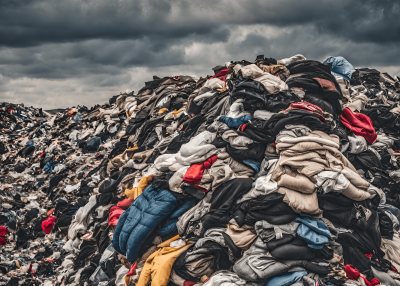In recent years, the term “fast fashion” has become increasingly popular, but do you really know what it means? Fast fashion is more than just a buzzword; it’s a phenomenon that has reshaped the way we consume clothing and its impact on the environment and society. In this blog post, we will delve into what fast fashion is, its characteristics, and how to identify it when you encounter it.
What is Fast Fashion?
Fast fashion refers to the rapid production of cheap, trendy clothing that quickly mimics the latest runway trends. The key elements that define fast fashion include:
Speedy Production
Fast fashion brands aim to bring new styles to market as quickly as possible. Traditional fashion seasons (spring, summer, winter, autumn) are no longer the norm. Instead they have been replaced by weekly or even daily releases, making it seem like there’s always something new in the stores.
The goal is to quickly respond to the latest fashion trends and get new styles into stores as fast as possible so fast fashion brands prioritize speed in all aspects of their supply chain from design to manufacturing to distribution.
Low Cost
Fast fashion items are often made from inexpensive materials and manufactured with cost-cutting measures to keep prices low. This affordability makes fashion accessible to a broader audience. Cost-cutting measures are employed at every stage of production to keep prices low for consumers.
The idea of buying clothing cheaply can be very exciting; finding a bargain gives a real dopamine hit! However, let’s consider the main ways that costs are kept low.
- Cheap labor used for garment manufacturing which is a result of low wages and poor labor standards and even slavery and child labour. Of the 60 million garment workers worldwide, only 10% are paid a living wage.
- Cheap materials, such as low-grade fabrics or synthetic fibers are used which do not stand the test of time and in the case of synthetics, leach microplastics into our waterways with every wash.
Replication of Trends
Fast fashion brands closely monitor fashion shows, celebrity styles, and social media for the latest trends. They then create clothing that mimics the designs of high-end fashion houses or popular designers but at a fraction of the cost. This “knock-off” approach allows consumers to stay on-trend without breaking the bank.
Disposable Fashion
Fast fashion encourages a culture of disposable clothing. Items are designed to be worn a few times and then discarded, contributing to significant textile waste. The low-quality materials and construction of these garments contribute to their short lifespan. The constant influx of new styles and the pressure to keep up with the latest trends drive this disposable mentality too. It is the low price that makes this high turnover possible for many people.
These characteristics of fast fashion collectively result in a fashion industry that is increasingly driven by consumerism, with an emphasis on quantity and speed over quality, sustainability and human rights.

But how can we identify fast fashion?
Spotting fast fashion isn’t always straightforward, but here are some tips to help you identify it when you’re shopping:
Low Prices
Be cautious of clothing that seems too good to be true. Extremely low prices usually indicates that corners have been cut in production, probably exploiting labor or using low-quality materials. Extremely low prices should raise a red flag when shopping for clothing. If something seems too good to be true in terms of cost, it likely indicates that corners have been cut during production.
Rapid Stock Turnover
If you notice that a store constantly introduces new items and frequently has sales, it’s a fast fashion retailer. This rapid turnover is designed to make consumers feel a sense of urgency that they must buy immediately to stay on-trend.
Traditional fashion retailers typically release new collections on a seasonal basis, while fast fashion retailers constantly churn out new styles to keep shoppers coming back and buying more than they really need.
Aggressive Marketing
Let me tell you a story:
I rarely buy new clothing, preferring to shop second hand but I needed some t-shirts so I found a brand I liked the look of and seemed sustainable.
I did my due diligence, thoroughly investigating the brand before I purchased from them. They used certified ethical manufacturing, 100% organic cotton, part proceeds donated to charity and used sustainable packaging. But…
As soon as I made the purchase, I was bombarded by texts and emails. Always promoting a sale or offering a bonus discount. Encouraging me to buy more, more, more.
I understand that businesses need to market themselves to make a profit but this was totally aggressive marketing.
It was driving overconsumption. So despite all the sustainable aspects of this company, I view them as being akin to a fast fashion brand.
Mass Production
Look for signs of mass production, such as a lack of attention to detail, loose threads, or inconsistent stitching. Fast fashion garment workers are under such pressure to churn out items that they are made quickly and with less attention to detail.
Synthetic Fabrics
Many fast fashion pieces are made from synthetic materials like polyester or nylon, which are cheaper to produce than natural fibers like cotton or wool. While synthetic fabrics can be durable and have their place in fashion, an overabundance of synthetic materials may indicate a focus on cost-cutting rather than quality.
Understanding what fast fashion is and how to identify it is essential for making informed choices as a consumer. While fast fashion can be tempting due to its affordability and trendiness, it comes with significant social and environmental costs. By being discerning shoppers and supporting sustainable fashion brands, we can make a positive impact on the fashion industry and work towards a more sustainable future.
So now you know what is fast fashion, will you try to avoid it?
Here’s some tips on how to avoid fast fashion:
- 10 Best Baby and Kids Second Hand Clothes Stores Online
- 20+ Places to buy second hand clothes online in Australia
- 8 Easy Tips on How to Dress Your Child More Sustainably
- 10 Tips For Outfit Shopping At A Thrift Store
- Repairable Shoes (for longer lasting footwear)
